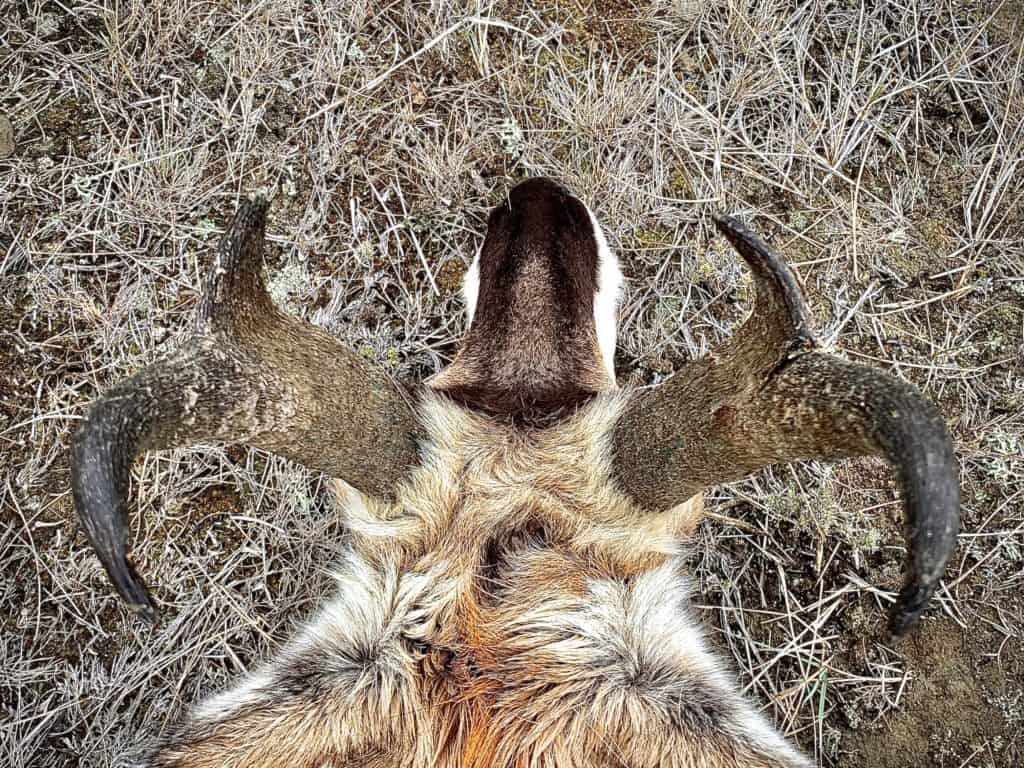
Our hearts were racing as we could feel my 4Runner start to bog down. We were five miles from the nearest county road. I could tell my wife Abbie was uneasy when she said that it reminded her of the last time we got stuck in the snow of the mountains of Colorado. We weren’t stuck yet though, but we both came to the realization that we would not get to hunt the area we had planned.
Sleepless Preparations
We had been looking forward to chasing Pronghorn in the sagebrush of Montana all year. The plains and sage country had grown to be our favorite type of terrain. At first glance, it is as flat as can be, but the many hidden folds can hold an overabundance of wildlife. Whitetail deer, mule deer, Hungarian Partridge, Sharptail Grouse, Sage Grouse, Jackrabbits, Cottontail Rabbits, and of course the Pronghorn antelope. We found ourselves rarely going into the mountains anymore, constantly setting up camp on the plains and spending days wandering them.
The week leading up to the hunt was full of excitement, packing up the vehicle days before we needed to, going over the list again and again making sure we could make the trip what we imagined. Even though we had camped in the same area two weeks before, we were excited to see what the trip would entail.
We weren’t going in light. We had our little 10×12 “wall tent” or “outfitters tent” that would be base camp for the trip. I bought this tent from a coworker. He wasn’t selling it but after me pestering him enough decided the money was worth getting me to shut up. He found this wall tent at a yard sale in Bozeman and it turned out to have a cool history to it. On the inside of the door flap were faded dates of moose hunts and high country fishing trips taken in the 80s.
This cozy little canvas shelter was perfect for two cots and all of the equipment associated with hunting and camping on a long weekend. We immediately began to add our own dates and hunts to the tent to further the story of this tent.
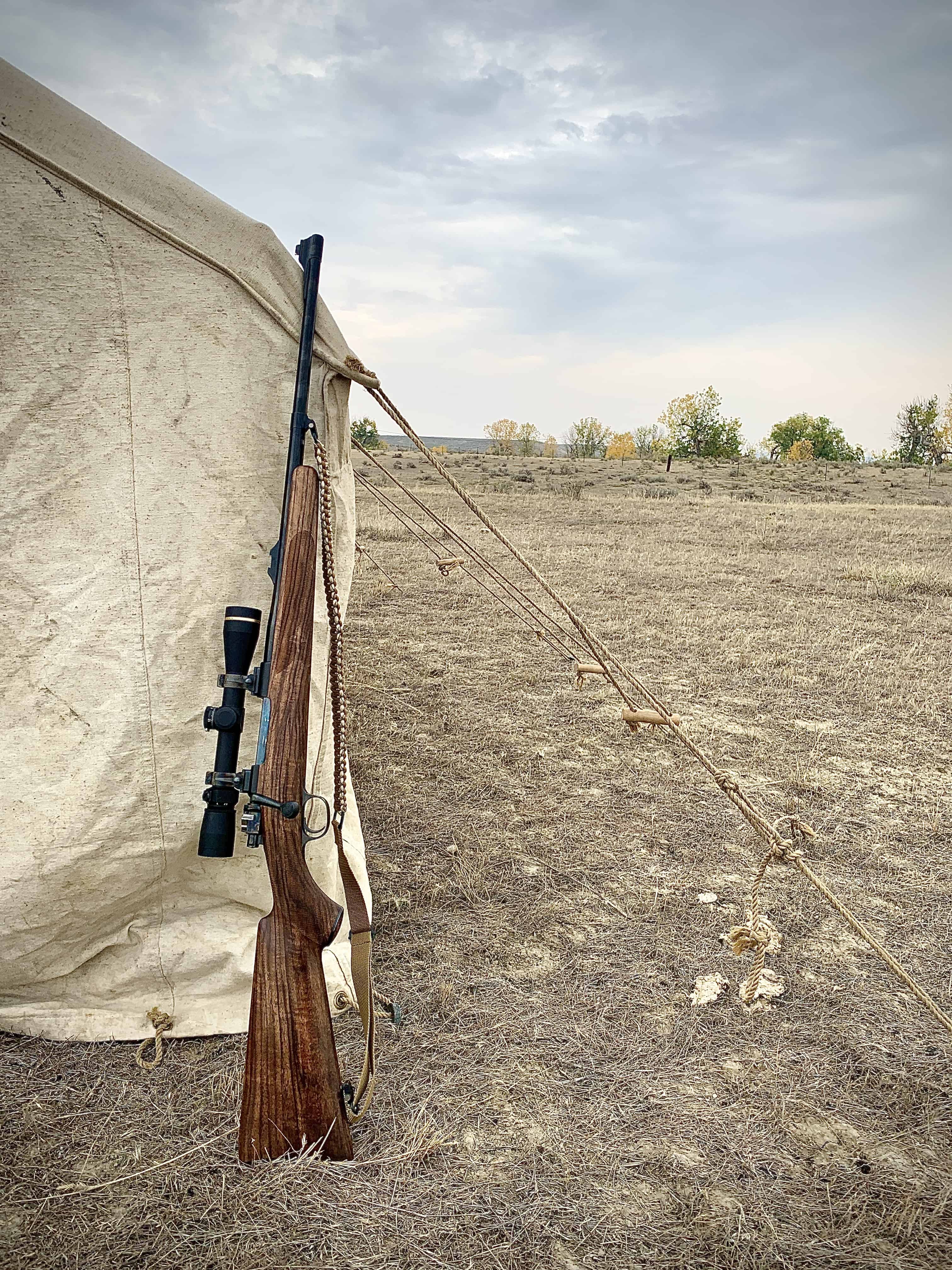
We left Thursday after I got out of work, making the couple hour drive arriving at our planned camping spot after dark. The next morning we would meet a Bureau of Land Management(BLM) employee to pick up our access permits as we would be hunting a type 2 BMA or Block Management Area.
Type 2 BMAs are private land that allows a limited number of hunters to sign up and hunt. The area we were signed up for was over 20,000 acres of walk-in only, which allowed only eight hunters to access each day. This was ideal for me, as I tend to put low hunting pressure above trophy quality for a hunting area. After getting our permits, we did some scouting and headed back to camp to relax and prep for the following day.
With stomachs full of camp-cooked burritos, we laid in our cots that night excited for the next morning.
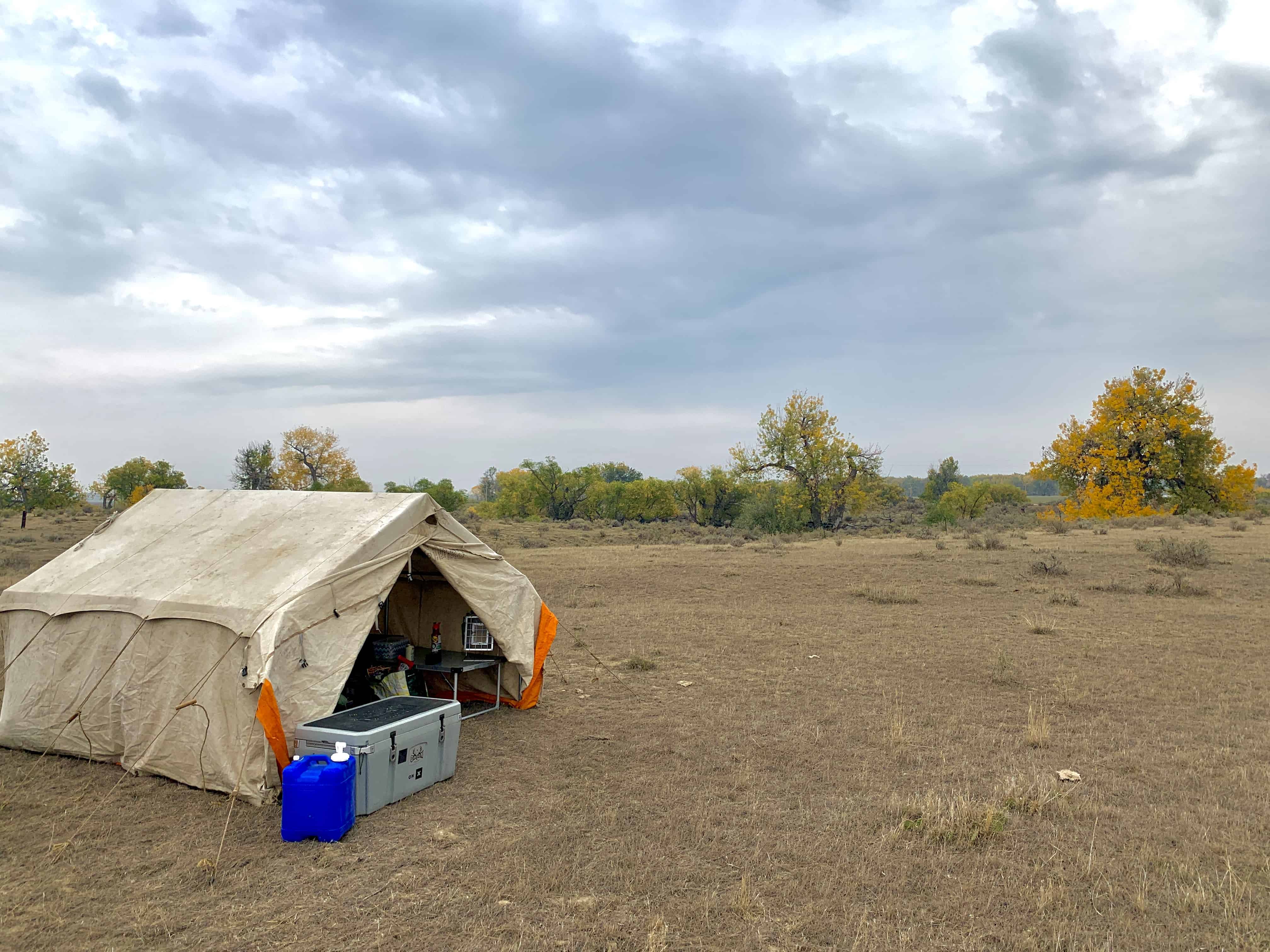
“Water is hitting me in the forehead”
“Water is hitting me in the forehead,” said my wife. That’s not something every husband dreams of hearing while camping. The forecast had shown light rain but not this much. It had rained steadily all night, after the year’s drought this was desperately needed, but we would have preferred that it waited a few days.
The rain had soaked the canvas tent to a point where it started to drip through in some places. One of those places happened to be directly above where my wife’s head was. Identifying a few other places, I fired up the propane heater with hopes of cooking it dry enough to buy us some time until morning.
We had always brought a tarp with us for this exact situation, but for some reason, it didn’t make the list on this trip. The heater did a great job stopping the leaks and by that time, my wife was sleeping away in my cot. With close to four hours before daylight, I fired up the cookstove. It was a good time to start the coffee and grab a book.
Mud
We loaded up the 4Runner and headed out. The wet roads started to concern us a little. We were on the county road at that time, but anyone who has spent any amount of time in Montana knows that this could mean anything. As we turned onto the ranch access road we could tell that the roads weren’t ideal. But you don’t need ideal to go hunting.
The further back we got, the worse it got. With five miles behind us and less than a half-mile to go, we started to bog down. I was in 4L with my center differential locked and still having trouble. Looking back on past experiences I decided I better find a place to turn around as it wasn’t going to get any better. I got out to assess the situation and was not thrilled.
The wheel wells were completely packed with thick mud that had a clay type of consistency. I grabbed the shovel out of my rig and tried to clear it the best I could. My effort seemed worthless as they filled right back up as soon as we started to drive again. We got turned around and headed back to the county road. On the way back we were happy to see a Sage Grouse flush off the road, as they are getting harder and harder to find.
Plan B or C or something
I always picture the first hours of the opening morning as being full of excitement. I’ve waited all year for this, now it is finally here. As the sun comes up, the vast landscape of sage changes colors and unveils whatever wildlife is out there. I shouldn’t be sitting in my vehicle during this time, I was frustrated but knew there wasn’t much I could do.
I met with the BLM employee and asked if there was any way to get my permissions changed to a different area in the region as I couldn’t access the one I had been assigned. I requested one that was much much smaller but you could access it from the county road. This section only allowed one hunter at a time and the hunter that had signed up for it was a no show.
A New Area
While our backup plan was a stretch we somehow got it to work. The new area was nowhere near the size of the one we had planned on hunting. While 2500 acres may seem like a lot, in sage country you feel like you can see every inch of it from a single vantage point.
I like to pronghorn hunt on my feet, glassing from the road just doesn’t excite me. I would much rather find and shoot an average buck miles from the road, than shoot a monster within arms reach of the truck. The county road bordered the edge of the area, meaning that you could theoretically ride the road and glass. Instead, we decided to pull off as soon as we entered the area. Parking the vehicle we wanted to explore the area on foot. At this point, we are a couple of hours into the first day and have yet to start hunting.
Picture this area being the shape of an “L”. The long part of the “L” is the BMA access area and the short side is state land. As we started hiking into the area we spotted a herd of antelope hanging out on some private land that was between the state and BMA land. We had looked at that herd from the road the day before and knew there was a shooter in there. However, they seemed to know their boundaries and showed no plans of leaving their feeding area.
We set out to hit a small ridge we could see off to our left. As we crested the ridge it unveiled a couple more ridges. All of which looked flat from the road. Our plan materialized and we started going from ridge to ridge glassing. The last ridge we hit didn’t look promising. I saw a white spot that I thought might be a pronghorn, but also thought it could be man-made.
At that point, my wife said, “what about those antelope there?”. Proving her position on the hunting team, I looked and saw at least 5 antelope right next to the spot I was focused on. We had a short laugh at my blindness and formulated a plan. It was her first hunt of this sort so it was very much a learning opportunity. Knowing they are right there at what we estimated 800-1000 yards, you’d think you should head straight for them.
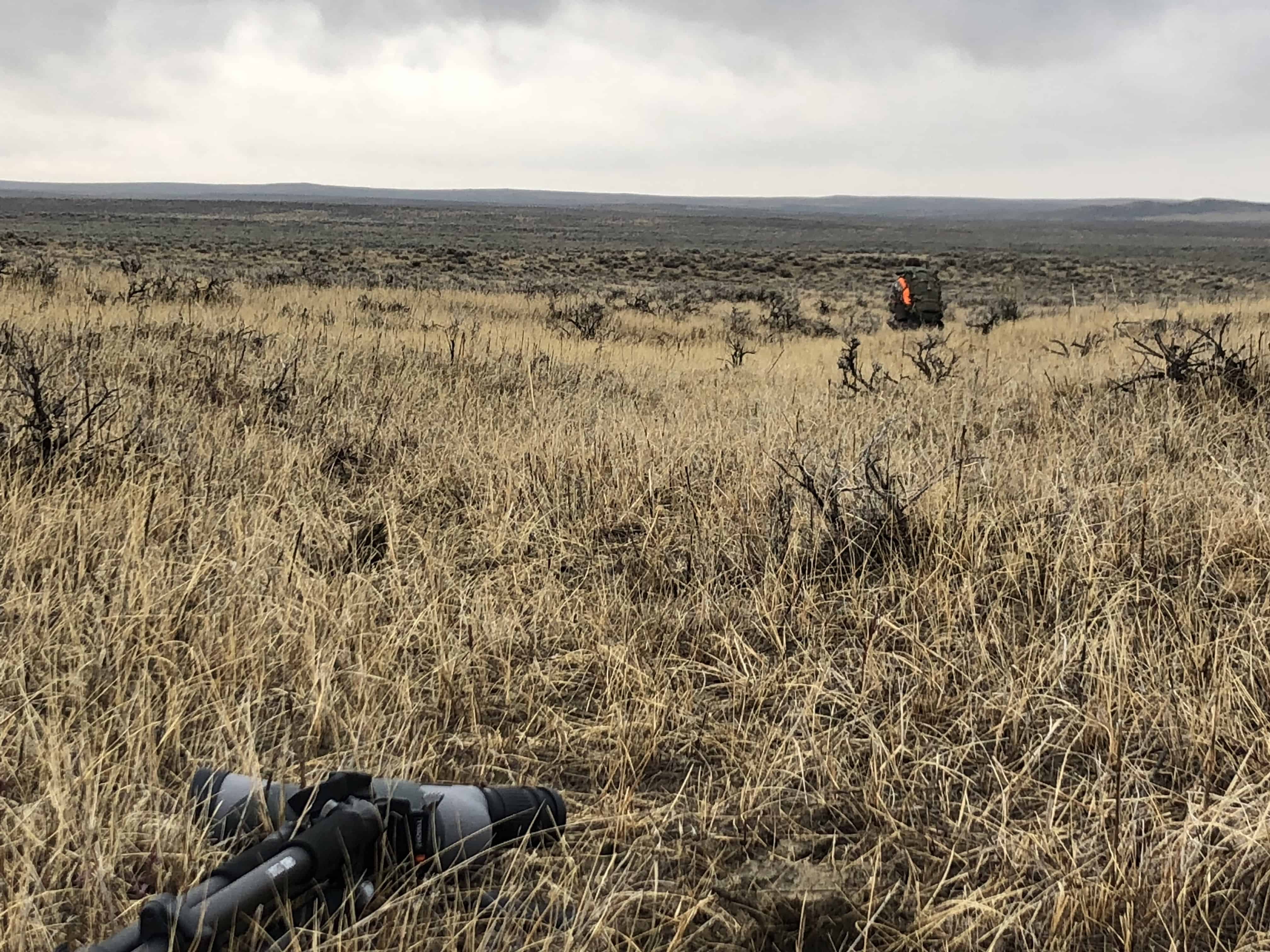
The 300 yard/half mile stalk
We slid back down the ridge and headed around the side where there was a small ditch. We crept slowly hunched over trying not to be seen. All of the sudden a doe antelope is standing 50 yards from me. I freeze and signal to my wife to stop. We crouch as low as possible, putting a hill between us. I whisper to my wife, she hands me the shooting sticks and I hand her the spotting scope. Having hunted pronghorn the last two years, I didn’t think this doe would be alone.
She stared at us, walked a little closer to inspect us, and continued feeding. My feet were numb and my leg was cramping just as she went over the knoll to our left. Surprisingly she was alone. Had we spooked her, she would have run right through the herd we were stalking, blowing them out and off the land we could hunt. I turned around to see Abbie’s face lit up with excitement as it was probably both of our closest encounters with antelope that year.
We made it to the targeted rise and settled down out of sight to grab a snack and formulate a plan. My rangefinder still wouldn’t pick up their range. Abbie was going to stay behind on the spotting scope and watch the events unfold. I had 300-400 yards of flat ground to cover to get into shooting range.
I started the stalk being very cautious of my approach. The wind was perfect so I knew that the only way they’d get me is by seeing me. I was constantly stopping and ranging them. Still no range. I cursed my rangefinder as it had given me trouble the year before in a similar situation. The 300 yards that I needed to cover quickly turned into a half-mile. The flats of sage really play tricks on your eyes.

Either 200 or 350 yds
I got to a range where I was more than close enough. The buck’s body filled a good portion of my ten-power binoculars, but I still couldn’t get a good range on him. 200 yards. 350 yards. I kept getting those reading consistently with my rangefinder. To those not familiar with this terrain, it plays tricks on you. Your range finder will either hit them or the sage in front or behind them. It is so flat that the sage in front and behind them may vary by a few hundred yards.
If you could get the exact range of an antelope 100% of the time they would be far easier to hunt. I have been a part of multiple hunts where that guess with the rangefinder screwed us. Last year my cousin and I crawled up to a herd of antelope trying to fill a doe tag. My rangefinder told me 75 yards and 220 yards. Thinking it was not possible we were that close we shot right over its back and it went on to live another day.
This played through my head as I began to steady my rifle on my backpack. I have my rifle sighted in for its Maximum Point Blank Range(MPBR). This means that out to a certain distance I will hit within 4 inches of my crosshairs up and down. At 200 yards my bullet would hit 3.4 inches high but at 350 yards I’d be almost 8 inches low.
Thinking that I was closer than 350 yards I elected to go with the closer range. I leveled the crosshairs on the center of the vitals. I felt very steady and eased the trigger. It broke and the herd started to run. Thinking there was no way I could’ve missed I spotted the buck. He looked to be in good shape as the herd looked around confused. I immediately began to question myself. Was there more than one buck? Did this one pop up after I dropped the other one? Or is it the same one?
Use coupon code KTG10 to get 10% off your order of $150 or more at Brownells.
I worked another cartridge into the chamber and after taking a few seconds to think about the situation I realized this was the same buck. I must have made a clean miss, so after some quick thinking I decided he was at 350 yards. I leveled the crosshairs on his back and broke the trigger.
As the rifle recoiled I saw the antelope collapse in the scope. Everything I had been looking forward to all year came into one moment. I quickly moved toward the pronghorn counting my steps. “100, 1, 2… 99, 200, 1, 2… 99, 300.” The buck came into sight. I was overly excited and turned to wave my wife forward. My pacing confirmed that this buck was at approximately 350 yards.
I’m always amazed at the colors of pronghorn. Each one seems to have been hand-painted and is unique in its own right. I was overwhelmed with excitement and just didn’t know how to react walking up to it. I stood there in silence taking it all in. Only in American can you do this. This animal will put a few months worth of meat in the freezer and make us one step closer to being self sustainable.

When my wife arrived at the buck we took a few pictures and started to process the animal. She has killed a few whitetail but has always been lucky enough to have her dad and cousins skin and gut it for her. She wanted to learn so we took our time as I showed her how to process an animal in the field. She took right to it and began skinning it, then removed a front shoulder.
We then loaded up our packs and headed in the direction of the vehicle. We had a mile and a half to pack the animal out, easy compared to some hunts. However, the pounds of mud that would build up on our boots made it challenging. Just about the time, your body would fully adjust to the extra weight the mud would let loose and surprise you. We made it back to the truck, enjoyed a celebratory beer, and ate our lunch.
Back to Camp
When we got back to camp our energy was drained. We took some naps and woke up with plans for tenderloin dinner. With a beautiful backdrop, we ate and relived the day’s adventure. It was her first western big game hunt, and she loved it.
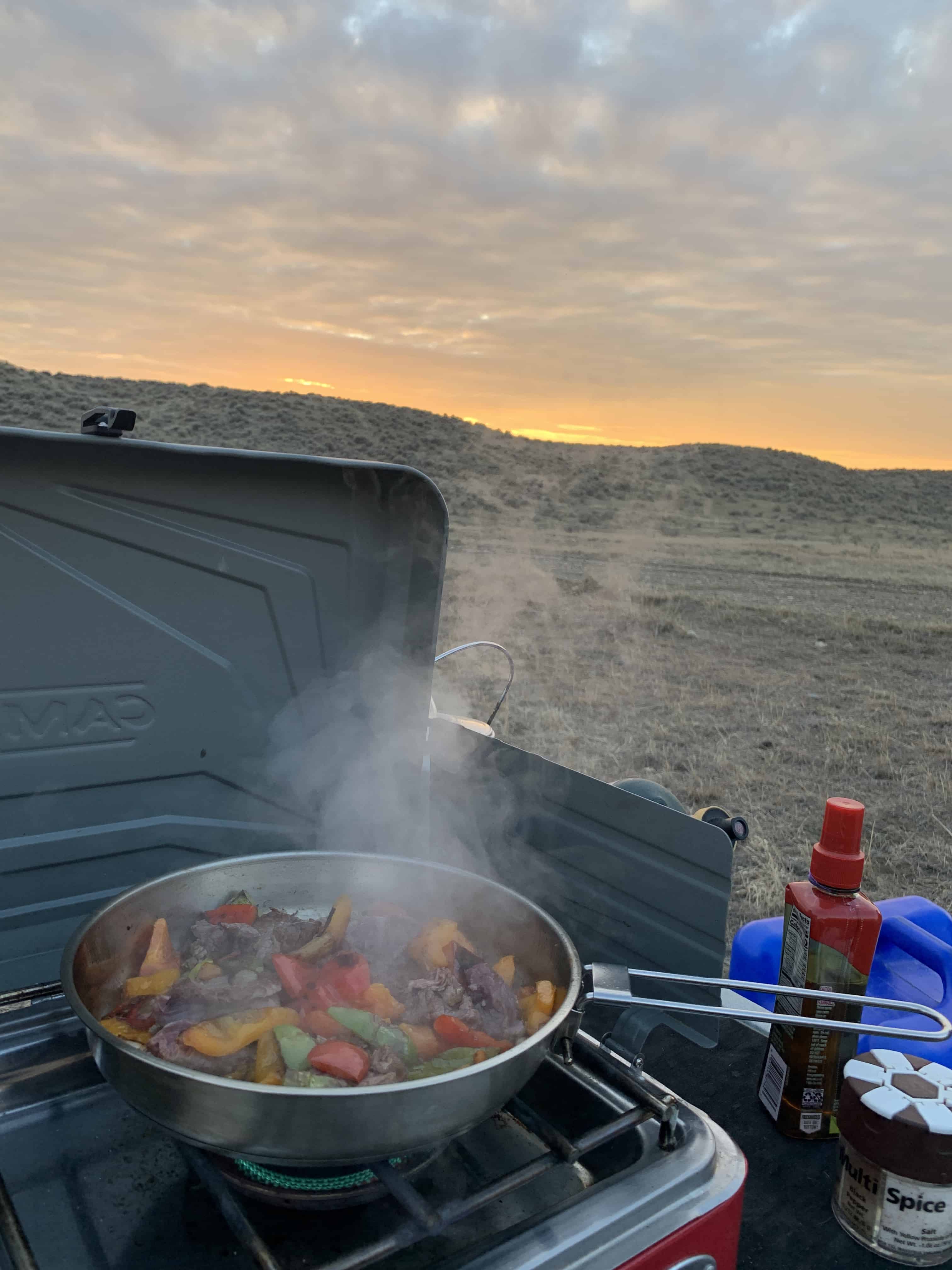
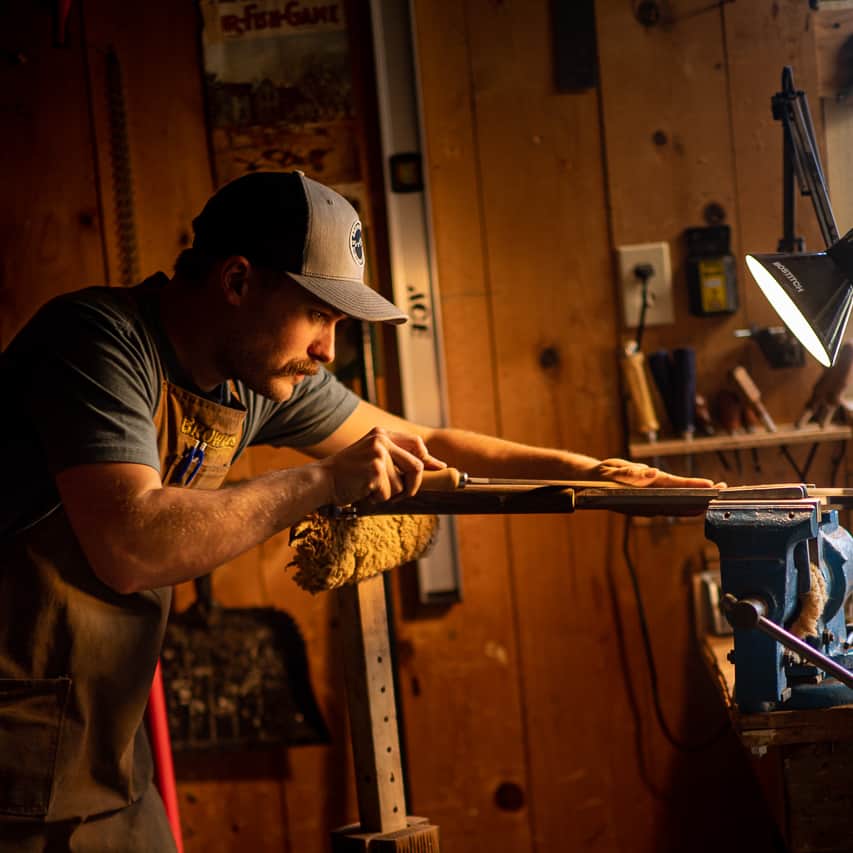
Written by: Kurt Martonik
Kurt is a Gunsmith, Reloader, Hunter, and Outdoorsman. He grew up in Elk County, Pennsylvania, where he became obsessed with the world of firearms. Following high school, Kurt enlisted in the United States Air Force as a Boom Operator, where he eventually rose to the position of Instructor. After his military service, he attended the Colorado School of Trades(CST) in Lakewood, CO for gunsmithing. Following graduation, he accepted a job at C. Sharps Arms in Montana, where he worked as a full time stockmaker and gunsmith.
Note: Most of the links in this article earn me a small commission at no cost to you. If you use these links, it helps me continue to put out free content for viewers. Thank you for the support!